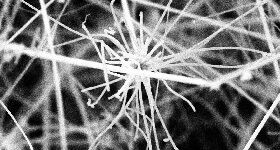Lateral Oxidation

Conventional Edge Emitting Lasers (EELs) emit a beam that, due to its divergence, is difficult to couple to a fiber without the aid of a special lens. Another disadvantage of EELs is their high threshold currents. Contrary to the EELs, Vertical Cavity Surface Emitting Lasers (VCSEL) emit a circular beam in the direction perpendicular to the diode surface.
VCSELs offer two notable advantages:
- Their better beam quality makes it more manageable in practical applications.
- Ease of testing during the production allows for higher yield, and hence, low production cost.
The structure of today’s VCSELs consists of a few quantum wells sandwiched between two reflector blankets. One of the methods used to confine the current is Selective Lateral Oxidation, and the resulting VCSELs are called Oxide-VCSELs. The material is oxidized around the aperture, thus confining the current distribution to the active area.
The process used to oxidize the VCSEL materials is Wet Oxidation. The VCSEL oxidation is mostly performed at temperatures below 400 °C. The selective lateral oxidation is know to greatly reduce optical losses, and the device outperform other conventional light sources.



